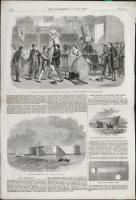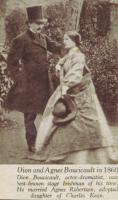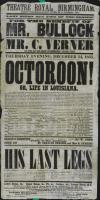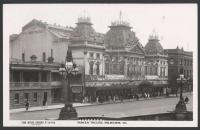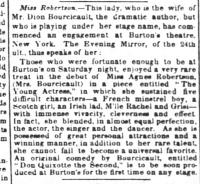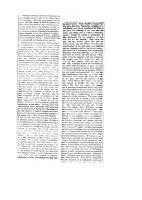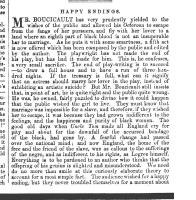Search
68 items
-
Illustrated London News newspaper article and illustration about the play in England
On July 18, 1860, the Boucicaults returned to England and on 18 November 1861, almost two years after its New York debut, the Boucicaults staged The Octoroon in London for the first time. For several weeks the Boucicaults performed The Octoroon as it was staged in America, ending with the character Zoe committing suicide. This article, from The London Illustrated News (30 November 1861) had chosen to illustrate the “sensation scene” of Zoe being sold as a slave at auction, and the reviewer commented “if it had been morally possible for the author to have given a happier ending to his drama it would have been more immediately popular.” In fact, London audiences vocally expressed their disapproval at the protracted and graphic death of the heroine. Letters were written to Boucicault, and published in the British press, imploring him to re-write the ending and allow Zoe to survive and marry her white suitor. At first Boucicault resisted, claiming that such a change would reflect a diminution of concern for enslaved women and destroy the artistry of his tragedy. Nevertheless, Boucicault swiftly adapted the play for London audiences, within weeks producing a version that ended with the promise of George and Zoe united in matrimony, though no marriage is seen to take place on stage. -
John Brown
John Brown was a controversial figure who played a major role in leading the United States to civil war. He was a devout Christian and lifelong abolitionist who tried to eradicate slavery from the United States through increasingly radical means. Unlike most abolitionists, Brown was not a pacifist and he came to believe that violence was necessary to dislodge slavery. He engaged in violent battles with pro-slavery citizens in Kansas and Missouri, and led a raid on the federal munitions depot at Harper’s Ferry. Although the raid failed spectacularly, it helped precipitate the Civil War and turned Brown into a martyr for the abolitionist cause. -
John Brown's raid on Harper's Ferry
Late on the night of October 16, 1859, John Brown and twenty-one armed followers stole into the town of Harper’s Ferry, Virginia, (now West Virginia) as most of its residents slept. The men–among them three free blacks, one freed slave, and one fugitive slave–hoped to spark a rebellion of freed slaves and to lead an “army of emancipation” to overturn the institution of slavery by force. To these ends the insurgents took some sixty prominent locals including Colonel Lewis Washington (great-grand nephew of George Washington) as hostages and seized the town’s United States arsenal and its rifle works. -
London, UK
The Octoroon opened in London at the Adelphi Theatre in 1861 -
Meeting of the Select Committee of the Legislative Council of Victoria
In 1858, shortly before The Octoroon was written, Australian legislator William Hull asserted to a Select Committee of the Legislative Council of Victoria, that it was "the design of Providence that the inferior races should pass away before the superior races . . . since we have occupied the country, the aborigines must cease to occupy it." -
Melbourne, Australia
The Octoroon was performed on the colonial stages of Australia a full ten months before it was staged in London. -
New York, NY
The Octoroon opened in New York City on December 1859 -
Opening night of Boucicault’s play "The Vampire" starring Agnes Robertson
Boucicault’s play, “The Vampire” at Princess’s Theatre, London, 19 year-old actress Agnes Robertson starred, met Dion Boucicault who appeared also in an acting role. -
Opening Night of the Britannia Theatre, Hoxton, reported in The Era, November 14, 1858
The ERA 14 November 1858 reported on the opening of the Britannia Theatre, Hoxton in their edition saying: ' Whatever may have been the anticipations of the most sanguine of those that come to behold the new and splendid theatre which Mr. Lane had erected on the site of the old Britannia Saloon - now, with the Lord Chamberlain's sanction, licensed to assume its prouder and more appropriate designation - we will venture to say that those expectations must have been more than realized by the elegance and the magnitude of the edifice in which they found themselves. It must be some eighteen years ago, to borrow a popular line from the melodramatic repertory, since we first went forth into the then almost unexplored region of Hoxton to visit the spacious establishment which was, at that period, of itself a wonder, newly founded by Mr. Samuel Lane for the amusement of the population more especially belonging to this district. The theatre was then equal to most minor theatres; the pieces, chiefly based on subjects and legends of local interest, were written, and well written, for the purpose, and more attention was paid to scenic and spectacular effect than was at that time to be observed at places of far higher pretensions. Gradually the audience came to understand the economy and enjoyment of an evening passed within its walls, and as the throng of visitors was increased by those who had found the fame of its productions penetrating the very heart of the metropolis, the limits of the original building were enlarged, its attractions multiplied, and new exertions were found necessary to provide sufficiency of accommodation for the substantial evidence if this extension of patronage. -
Photo Dion Boucicault and Agnes Robertson together c 1860
Dionysius Lardner Boucicault (Dion) was born in Dublin in 1820. Though he took the family name of his mother’s husband (Samuel Boursiquot), his biological father was most likely Dr. Dionysius Lardner (1793-1859), who had had an affair with Boucicault’s mother, Anna (nee Darley). Boucicault’s first theatrical success in 1842, was under the assumed name of Lee Moreton, and the play, London Assurance, has been staged as recently as 2010, starring Russell Beale and Fiona Shaw, at the Olivier Theatre. The image here is of Boucicault with his second wife, famous actress, Agnes Robertson, who starred as Zoe Peyton in The Octoroon and whose performances in this and other Boucicault plays cemented their success on stage. -
Playbill - Royal Queen's Theatre and Opera House - February 1862
This playbill from Royal Queen's Theatre and Opera House Edinburgh, February 26 and 27, 1862, is just a couple of months after the London premier of Boucicault's "rewritten" version where Zoe survives. This bill announced: "[t]he great sensation drama in five acts entitled the Octoroon." This playbill features an account of a purported "true story" of a Miss Winchester who, like the fictional Zoe, was described as "the natural child of the planter by a quadroon slave; she was inventoried in chattels of the estate and sold; the next day her body was found floating in the Ohio river." The playbill declared, "[s]uch is the truth which underlies the story of the Octoroon." Presumably, the production of The Octoroon advertised in this manner would feature a mixed-race heroine who commits suicide but the scenes listed on the same playbill also include the duel that Boucicault introduced in the final act in the version in which Zoe survived, which complicates ways in which The Octoroon produced in each locale participated in debates about race and slavery. The story of "Miss Winchester" was reprinted in a later playbill from Birmingham December 14, 1865. Special Collections, Templeman Library, University of Kent. -
Playbill Royal Queen's Theatre and Opera House Edinburgh, February 1862
Just months after the London premier of Boucicault's "rewritten" version where Zoe survives, this playbill announced "[t]he great sensation drama in five acts entitled the Octoroon." This playbill features an account of a purported "true story" of a Miss Winchester who, like the fictional Zoe, was described as "the natural child of the planter by a quadroon slave; she was inventoried in chattels of the estate and sold; the next day her body was found floating in the Ohio river." The playbill declared, "[s]uch is the truth which underlies the story of the Octoroon." Presumably, the production of The Octoroon advertised in this manner would feature a mixed-race heroine who commits suicide but the scenes listed on the same playbill also include the duel that Boucicault introduced in the final act in the version in which Zoe survived. -
Playbill Theatre Royal, Birmingham December 14 1865
The Playbill for the Theatre Royal, Birmingham advertises a performance of The Octoroon for Thursday December 14, 1865. This playbill repeats the story of “Miss Winchester,” which had been included in the playbill for the Royal Queen's Theatre and Opera House Edinburgh, February 1862. This playbill does not include a scene list. -
Playbill Theatre Royal, Sheffield, 1862
This playbill, held at the University of Canterbury Kent’s Templeman Library, from the Theatre Royal Sheffield, advertises “positivity the last representation in Sheffield,” of The Octoroon and another of Boucicault’s dramas, The Colleen Bawn. The playbill is significant in pointing out the “new and effective arrangement” of The Octoroon, “which, whilst it improves, shortens the length of the drama” and the scene lit indicates that it is the four-act version performed, including the sensation scene of the “Magnolia on Fire.” The playbill is also important in advertising The Colleen Bawn and The Octoroon as a full night’s entertainment, which newspaper advertisements of this period indicate became a regular feature of provincial theatres at the time. The Colleen Bawn dates from around the same time as The Octoroon – and was the first new Boucicault play to be performed in New York in the aftermath of that incendiary production. In 1859, having departed from the Winter Garden Theatre and the production of The Octoroon that had caused so much controversy, Dion Boucicault and Agnes Robertson joined with Laura Keene’s Varieties Theatre and began to stage a series of “Irish” melodramas, one of which was The Colleen Bawn. When Boucicault and Robertson returned to London in 1860, they opened at the New Royal Adelphi Theatre with The Colleen Bawn, which was an immediate and lasting success. -
Princess's Theatre, Australia
The Octoroon was performed on the colonial stages of Australia. -
Princess's Theatre, London
When he returned to England in 1860, Dion Boucicault initially teamed up with the management at the New Adelphi Royal Theatre. By 1862, he was experiencing financial difficulties and was declared bankrupt. For short period, he moved, with Agnes Robertson to Liverpool. On his return to London, Boucicault set up in partnership with George Vining at the Princess’s Theatre while also selling permissions to other theatre managers for his plays to be performed under licence throughout England, Scotland and Ireland. -
Princess's Theatre, London
When he returned to England in 1860, Dion Boucicault initially teamed up with the management at the New Adelphi Royal Theatre. By 1862, he was experiencing financial difficulties and was declared bankrupt. For short period, he moved, with Agnes Robertson to Liverpool. On his return to London, Boucicault set up in partnership with George Vining at the Princess’s Theatre while also selling permissions to other theatre managers for his plays to be performed under licence throughout England, Scotland and Ireland. -
Review of first night in Melbourne
The Melbourne Argus reviewed the opening night of The Octoroon in Australia, featuring Madame Marie Duret, with a brief retelling of the plot and a critical commentary on Boucicault’s “stagey” and “claptrap” writing which it described, pejoratively as “seeking after effects.” Praise was bestowed on the cast, however, and a long run predicted. But the review did not express dismay at the death of the heroine. In Australia, where the lives and humanity of indigenous women were constantly threatened, like those of enslaved women in America, the heroine's suicide largely was accepted and applauded as an appropriate, if necessary, conclusion to the melodrama. -
Review of Joseph Jefferson as Salem Scudder at Princess's Theatre in Melbourne Australia, 27 May 1862
American actor Joseph Jefferson III, played the character Salem Scudder in the original American production when the play opened in New York. He then regularly performed as Scudder on his Australian tours, the first in 1862, by which time The Octoroon had been toured across Australia by both Madame Marie Duret and another American actor, Charles Wheatleigh. According to Jefferson’s autobiography, published in 1889, his 1862 production of the play met with a "most satisfactory" reception when he performed it at the Princess's Theatre in Melbourne. Jefferson's staging of The Octoroon in Australia ended with Zoe's suicide just as it had done in his original Winter Garden production in New York. -
Review of the new ending of "The Octoroon," featuring Zoe's survival, "Happy Endings," Saturday Review: Politics, Literature, Science and Art, 1861
Once had Boucicault adapted the play for London audiences that ended with the promise of George and Zoe united in matrimony, the December 21 issue of the Saturday Review attempted an interpretation (“Happy Endings,” Saturday Review (December 21, 1861); 634. They commended Boucicault's newly changed “happy” ending on the very grounds that The Octoroon was “not a play that appeals to deep feelings, or that is calculated to awake the emotions of highly-wrought pity and tenderness." And speaking on behalf of the audience, the Saturday Review claimed it "as a kind of right that we shall not be plunged suddenly and wantonly into the region of pain.” The reviewer further claimed “the audience wished for a happy ending, but they never troubled themselves for a moment about the rights or wrongs of slavery.” Therefore, according to this reviewer, the audiences’ audible disapproving reaction to Zoe's death may have been merely a commentary on the dramatic weakness of the suicide scene, rather than compassion for the enslaved mixed-race woman subject to sexual slavery. -
Royal Queen's Theatre and Opera House Edinburgh
The Illustrated London News reported on the Queen's Theatre and Opera House in their 14th of February 1857 edition:- “This newly built theatre […] is considered to be creditable to the taste and skill of the architect, both as regards the picturesque frontage of the building and the commodious and convenient construction of the interior.” The Royal Patent from the former Theatre Royal, Shakespeare Square, Edinburgh was transferred to the Broughton Street Theatre in 1859 after the Shakespeare Square Theatre was demolished. Sadly in January 1865 the Queen's Theatre and Opera House was also destroyed by fire. [http://www.arthurlloyd.co.uk/Edinburgh/TheatreRoyal.htm] -
Royal Queen's Theatre and Opera House Edinburgh
The Illustrated London News reported on the Queen's Theatre and Opera House in their 14th of February 1857 edition:- “This newly built theatre […] is considered to be creditable to the taste and skill of the architect, both as regards the picturesque frontage of the building and the commodious and convenient construction of the interior.” The Royal Patent from the former Theatre Royal, Shakespeare Square, Edinburgh was transferred to the Broughton Street Theatre in 1859 after the Shakespeare Square Theatre was demolished. Sadly in January 1865 the Queen's Theatre and Opera House was also destroyed by fire. [http://www.arthurlloyd.co.uk/Edinburgh/TheatreRoyal.htm] -
Royal Queen's Theatre and Opera House Edinburgh, February 26 and 27, 1862
This playbill from Royal Queen's Theatre and Opera House Edinburgh, February 26 and 27, 1862, is just a couple of months after the London premier of Boucicault's "rewritten" version where Zoe survives. This bill announced: "[t]he great sensation drama in five acts entitled the Octoroon." This playbill features an account of a purported "true story" of a Miss Winchester who, like the fictional Zoe, was described as "the natural child of the planter by a quadroon slave; she was inventoried in chattels of the estate and sold; the next day her body was found floating in the Ohio river." The playbill declared, "[s]uch is the truth which underlies the story of the Octoroon." Presumably, the production of The Octoroon advertised in this manner would feature a mixed-race heroine who commits suicide but the scenes listed on the same playbill also include the duel that Boucicault introduced in the final act in the version in which Zoe survived, which complicates ways in which The Octoroon produced in each locale participated in debates about race and slavery. The story of "Miss Winchester" was reprinted in a later playbill from Birmingham December 14, 1865. Special Collections, Templeman Library, University of Kent. -
Saving The Octoroon
Once Dion Boucicault had changed the ending of his famous play, The Octoroon, British satiric periodical, Punch, published a thirteen-stanza parodic poem, "Saving the Octoroon," ("Saving The Octoroon." Punch, or the London Charivari, 21 Dec. 1861, p. 252) that lampooned both the motivation and effect of Boucicault's revision.

